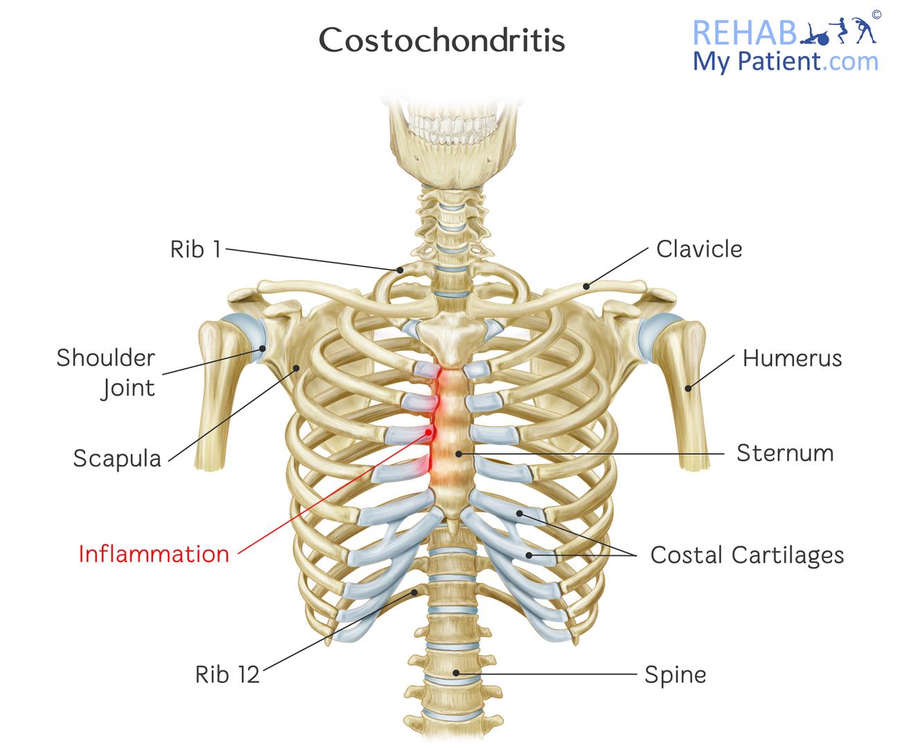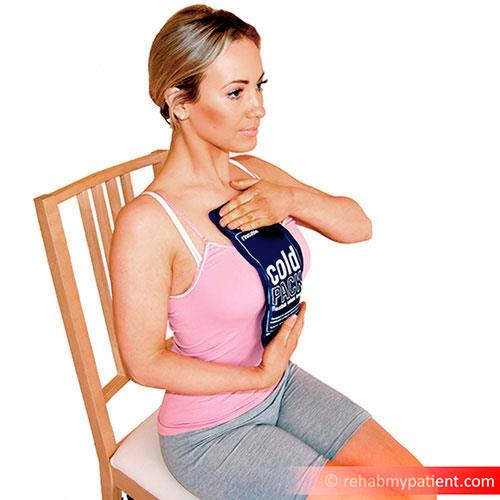Costochondritis
Posted on 01st Jul 2018 / Published in: Ribs , Thoracic Spine

Costochondritis is when the cartilage connecting the breastbone and the rib becomes inflamed, the junction is referred to as the costosternal joint. Pain from this condition can mimic the signs of a heart attack and various other conditions relating to the heart. It can also mimic the signs of acid reflux and indigestion. Pains can also travel to the spine and between the shoulder blades. Some doctors refer to costochondritis as costosternal chondrodynia, chest pain or costosternal syndrome, or Tietze’s syndrome.
Most of the time, those who have costochondritis don’t have an attributed cause to their condition, although research tells us that poor posture is often to blame. Occasionally it can be caused by trauma.
Costochondritis Anatomy
The chest consists of the portion of the trunk located between the abdomen and the neck. It holds the lungs and the heart, as well as that of the esophagus and the large blood vessels connecting the heart. Inside of the chest wall, you will find cartilage, bones, ligaments and muscles holding all of the chest contents together. The rib cage consists of the ribs, sternum and the vertebrae. The ribs are connected
with the vertebrae in the back and to the sternum in the front. Ribs, joints between all of the vertebrae and the sternum let the bones move freely. Soft tissues, such as the muscles, ligaments and nerves, make up the chest wall.

Symptoms:
- Pain over the sternum and upper chest
- Usually worse after exercise
- Worse taking a deep breath in
- Inflammation (redness, swelling over the area)
- Pain may be referred to the arms or shoulder
It is important for the physician to exclude more serious pathology e.g. heart or cardiovascular problems as costochondritis may feel like a heart attack. It is also not unusual to be investigated for reflux or digestive problems, which can mimic the signs of costochondritis.
- Symptoms should ease in 4-8 weeks
- All symptoms should disappear in 6 months
- Having the condition once does not increase your chances of having the condition again
How to Treat Costochondritis:
- Stretching Exercises
Undergoing gently, range-of-motion exercises has proven to be helpful in overcoming this condition. - Nerve Stimulation
This procedure is known as TENS, which is a device that sends a small electrical current by patches on the surface of the skin close to the area in pain. This can mask or interrupt pain signals, which will prevent them from ever getting to your brain in the first place. - Physical Therapy
Manual and physical therapists are brilliant at improving posture, improving mobility to your ribs and spine, and reducing the muscle tension that pulls on the ribs. - Medication
You doctor may prescribe you anti-inflammatories, painkillers to reduce the pain and inflammation. Low dosage anti-depressants such as Amitriptyline is often used to control chronic pain, especially for those who are struggling to sleep at night. - Cold Application
It is widely agreed that costochondritis is an inflammatory condition. So one of the best ways to treat it is with an ice pack or frozen peas. Place them over your chest, where your pain is located, wrapped in a tea towel for 5-10 minutes three times per day. This is effective in reducing the pain and inflammation. You may need to continue this for several weeks.
Tips:
- Women and those over the age of 40 are most prone to costochondritis.
- Encourage children to use their school bags correctly. The bag shouldn’t be too heavy or else their shoulders will slump. Show them how to carry the bag the right way.
- Avoid any activities that trigger the pain. If tenderness and chest pain result from physical exertion, ask about safe guidelines for lifting and an exercise program.
- Severe coughing and other strenuous activities are attributed to costochondritis.
- Maintain good posture at work. Keep upright. Ensure your computer work station is set up correctly with the monitor at the correct height. All too often costochondritis is caused by poor posture.
- Avoid stress as much as possible. Take steps to relax regularly through the week. Try deep breathing exercises, watching a good movie, or reading a book to de-stress.
- You should make a gradual return to exercise, using slow stretching to avoid re-injury.
Sign UP
Sign up for your free trial now!
Get started with Rehab My Patient today and revolutionize your exercise prescription process for effective rehabilitation.
Start Your 14-Day Free Trial